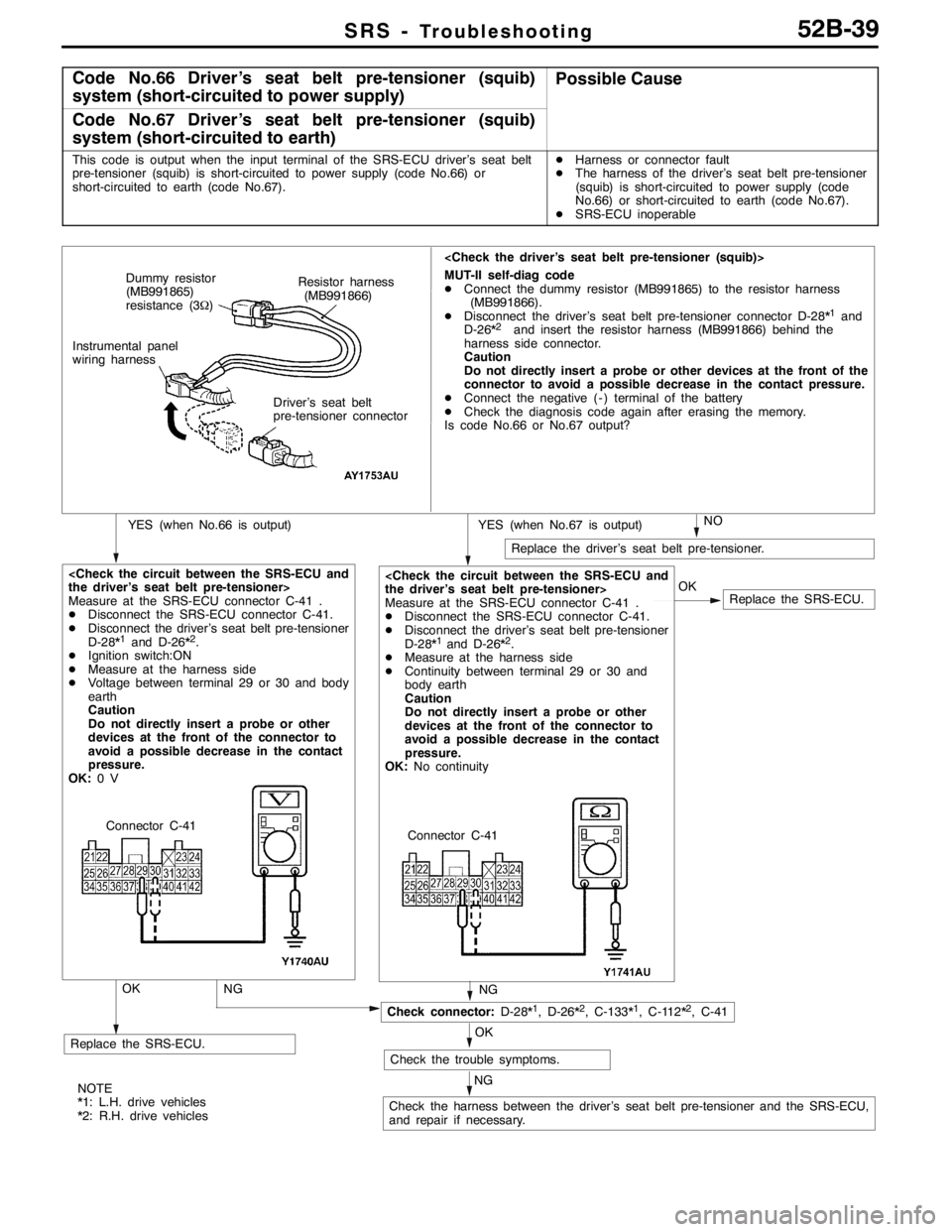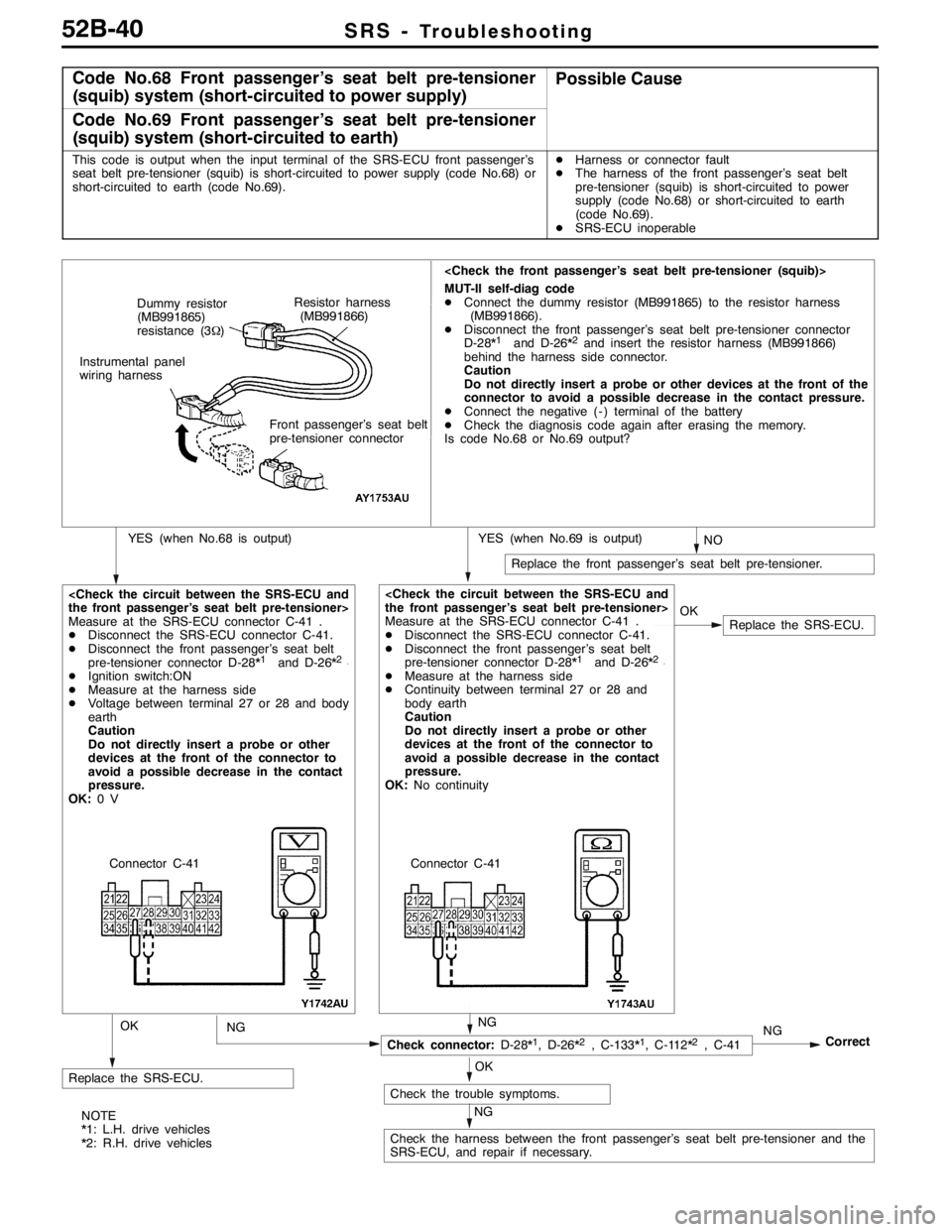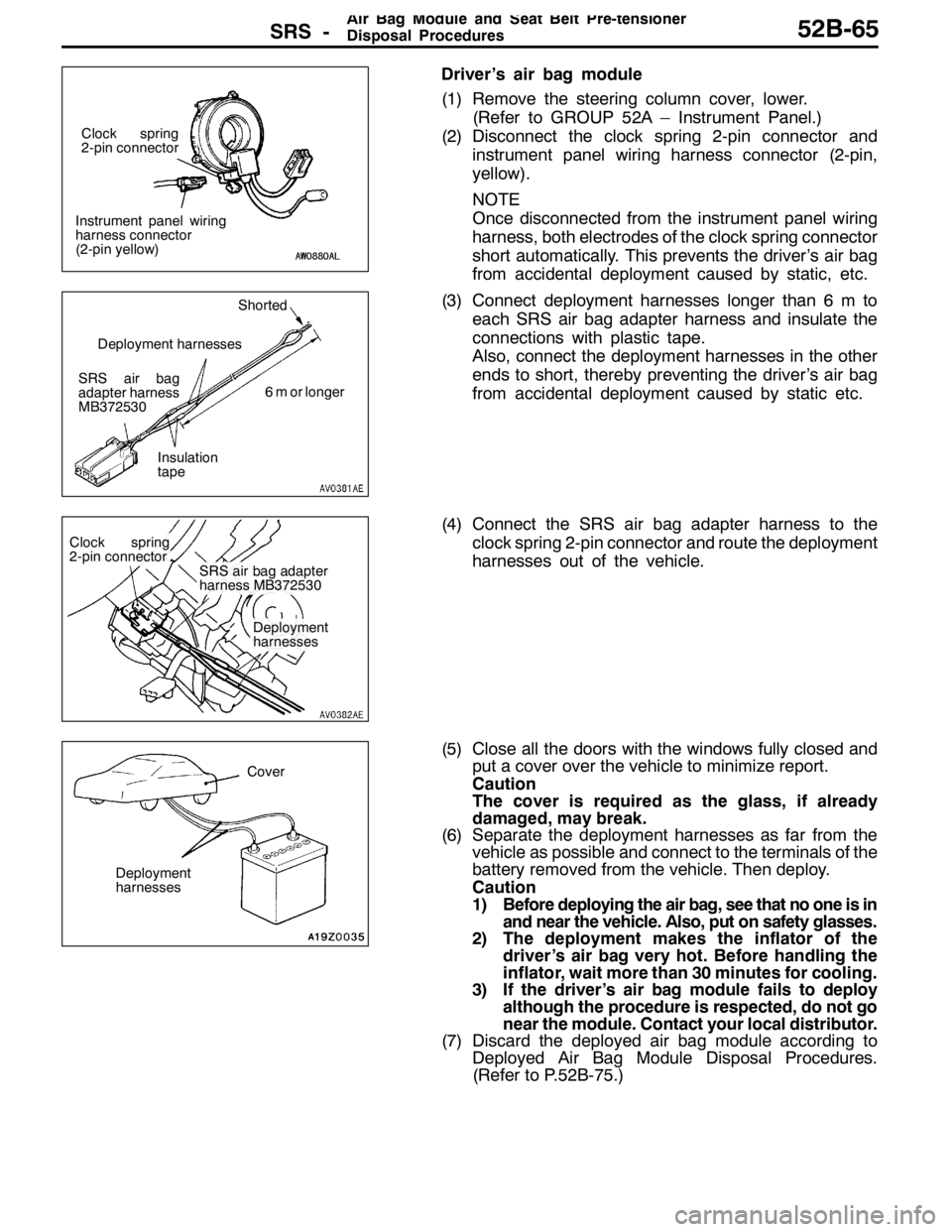2007 MITSUBISHI LANCER EVOLUTION instrument panel
[x] Cancel search: instrument panelPage 1283 of 1449

SRS -Troubleshooting52B-39
Code No.66 Driver’s seat belt pre-tensioner (squib)
system (short-circuited to power supply)Possible Cause
Code No.67 Driver’s seat belt pre-tensioner (squib)
system (short-circuited to earth)
This code is output when the input terminal of the SRS-ECU driver’s seat belt
pre-tensioner (squib) is short-circuited to power supply (code No.66) or
short-circuited to earth (code No.67).DHarness or connector fault
DThe harness of the driver’s seat belt pre-tensioner
(squib) is short-circuited to power supply (code
No.66) or short-circuited to earth (code No.67).
DSRS-ECU inoperable
Replace the SRS-ECU. OK
Measure at the SRS-ECU connector C-41 .
DDisconnect the SRS-ECU connector C-41.
DDisconnect the driver’s seat belt pre-tensioner
D-28*
1and D-26*2.
DMeasure at the harness side
DContinuity between terminal 29 or 30 and
body earth
Caution
Do not directly insert a probe or other
devices at the front of the connector to
avoid a possible decrease in the contact
pressure.
OK:No continuity
NO
Replace the driver’s seat belt pre-tensioner.
MUT-II self-diag code
DConnect the dummy resistor (MB991865) to the resistor harness
(MB991866).
DDisconnect the driver’s seat belt pre-tensioner connector D-28*
1and
D-26*2and insert the resistor harness (MB991866) behind the
harness side connector.
Caution
Do not directly insert a probe or other devices at the front of the
connector to avoid a possible decrease in the contact pressure.
DConnect the negative ( - ) terminal of the battery
DCheck the diagnosis code again after erasing the memory.
Is code No.66 or No.67 output?
YES (when No.67 is output)YES (when No.66 is output)
Replace the SRS-ECU.
Measure at the SRS-ECU connector C-41 .
DDisconnect the SRS-ECU connector C-41.
DDisconnect the driver’s seat belt pre-tensioner
D-28*
1and D-26*2.
DIgnition switch:ON
DMeasure at the harness side
DVoltage between terminal 29 or 30 and body
earth
Caution
Do not directly insert a probe or other
devices at the front of the connector to
avoid a possible decrease in the contact
pressure.
OK:0V
NG
Check connector:D-28*1, D-26*2, C-133*1, C-112*2, C-41
Check the trouble symptoms.
Check the harness between the driver’s seat belt pre-tensioner and the SRS-ECU,
and repair if necessary.
NG
OK
NG
OKResistor harness
(MB991866) Dummy resistor
(MB991865)
resistance (3Ω)
Instrumental panel
wiring harness
Driver’s seat belt
pre-tensioner connector
Connector C-41
Connector C-41
NOTE
*1: L.H. drive vehicles
*2: R.H. drive vehicles
Page 1284 of 1449

SRS -Troubleshooting52B-40
Code No.68 Front passenger’s seat belt pre-tensioner
(squib) system (short-circuited to power supply)Possible Cause
Code No.69 Front passenger’s seat belt pre-tensioner
(squib) system (short-circuited to earth)
This code is output when the input terminal of the SRS-ECU front passenger’s
seat belt pre-tensioner (squib) is short-circuited to power supply (code No.68) or
short-circuited to earth (code No.69).DHarness or connector fault
DThe harness of the front passenger’s seat belt
pre-tensioner (squib) is short-circuited to power
supply (code No.68) or short-circuited to earth
(code No.69).
DSRS-ECU inoperable
NO
Replace the front passenger’s seat belt pre-tensioner.
MUT-II self-diag code
DConnect the dummy resistor (MB991865) to the resistor harness
(MB991866).
DDisconnect the front passenger’s seat belt pre-tensioner connector
D-28*
1and D-26*2and insert the resistor harness (MB991866)
behind the harness side connector.
Caution
Do not directly insert a probe or other devices at the front of the
connector to avoid a possible decrease in the contact pressure.
DConnect the negative ( - ) terminal of the battery
DCheck the diagnosis code again after erasing the memory.
Is code No.68 or No.69 output?
YES (when No.69 is output)YES (when No.68 is output)
Replace the SRS-ECU.
Measure at the SRS-ECU connector C-41 .
DDisconnect the SRS-ECU connector C-41.
DDisconnect the front passenger’s seat belt
pre-tensioner connector D-28*
1and D-26*2.
DIgnition switch:ON
DMeasure at the harness side
DVoltage between terminal 27 or 28 and body
earth
Caution
Do not directly insert a probe or other
devices at the front of the connector to
avoid a possible decrease in the contact
pressure.
OK:0V
NG
Replace the SRS-ECU.
Correct
Check connector:D-28*1, D-26*2, C-133*1, C-112*2, C-41
Check the trouble symptoms.
Check the harness between the front passenger’s seat belt pre-tensioner and the
SRS-ECU, and repair if necessary.OK
Measure at the SRS-ECU connector C-41 .
DDisconnect the SRS-ECU connector C-41.
DDisconnect the front passenger’s seat belt
pre-tensioner connector D-28*
1and D-26*2.
DMeasure at the harness side
DContinuity between terminal 27 or 28 and
body earth
Caution
Do not directly insert a probe or other
devices at the front of the connector to
avoid a possible decrease in the contact
pressure.
OK:No continuity
NG
OK
NG
OK
NG
Resistor harness
(MB991866) Dummy resistor
(MB991865)
resistance (3Ω)
Instrumental panel
wiring harness
Front passenger’s seat belt
pre-tensioner connector
Connector C-41 Connector C-41
NOTE
*1: L.H. drive vehicles
*2: R.H. drive vehicles
Page 1288 of 1449

SRS - SRS Maintenance52B-44
REPLACE ANY VISUALLY INSPECTED PART IF IT
FAILS THAT INSPECTION. (Refer to P.52B-52.)
Caution
The SRS may not activate if any of the above
components is not installed properly, which could
result in serious injury or death to the vehicle’s driver
or front passenger.
INSTRUMENT PANEL WIRING HARNESS
Instrument panel wiring harness
1. Check connector for poor connection.
2. Check harnesses for binds, connectors for damage, and
terminals for deformation.
REPLACE ANY CONNECTORS OR HARNESS THAT
FAIL THE VISUAL INSPECTION. (Refer to P.52B-3.)
Caution
The SRS may not activate if SRS harnesses or
connectors are damaged or improperly connected,
which could result in serious injury or death to the
vehicle’s driver or front passenger.
POST-INSTALLATION INSPECTION
Reconnect the negative battery terminal. Turn the ignition
switch to the ON position. Does the SRS warning lamp
illuminate for about 7 seconds, and then go out? If yes, SRS
system is functioning properly. If no, consult page 52B-6.
SRS warning lamp
Page 1289 of 1449

SRS - Post-collision Diagnosis52B-45
POST-COLLISION DIAGNOSIS
Whether or not the air bags have deployed, check and service
the vehicle after collision as follows:
SRS-ECU MEMORY CHECK
1. Connect the MUT-IIto the diagnosis connector. (Refer
to GROUP 00 – How to Use Troubleshooting/Inspection
Service Points.)
Caution
Refer to that the ignition switch is LOCK(OFF) when
connecting or disconnecting MUT-II.
2. Read (and write down) all displayed diagnosis codes.
(Refer to P.52B-9.)
NOTE
If battery power supply has been shut down by the
collision, the MUT-IIcannot communicate with the
SRS-ECU. Check and, repair if necessary, the instrument
panel wiring harness before the next job.
3. Use the the MUT-IIto read the data list (how long trouble(s)
have continued and how often memory have been
erased).
Data list
NoService Data ItemApplicability
92Number indication how often the memory is cleared.Maximum time to be stored: 250
93How long problem have lasted (How long it takes
from the occurrence of the problem till the first air bag
squib igniting signal)Maximum time to be stored: 9999 minutes
(approximately 7 days)
94How long problem(s) have lasted (How long it takes
from the first air bag squib igniting signal till now.)
4. Erase the diagnosis codes and after waiting 5 seconds
or more read (and write down) all displayed diagnosis
codes. (Refer to P.52B-9.)
Page 1292 of 1449

SRS - Post-collision Diagnosis52B-48
Steering wheel, steering column and intermediate joint
1. Check the driver’s air bag module for proper installation
to the steering wheel.
2. Check the steering wheel for noise, binds or difficult
operation and excessive free play.
Harness connector (Instrument panel wiring harness,
Floor wiring harness)
Check the harness for binds, the connector for damage and
the terminals for deformation. (Refer to P.52B-44.)
Seat belt with pre-tensioner
1. Check the seat belt for damage or deformation.
2. Check the pre-tensioner for cracks or deformation.
3. Check the harness or the connector for damage, and
the terminal for deformation.
4. Check that the unit is installed correctly to the vehicle
body.
Page 1299 of 1449

SRS - Air Bag Modules and Clock Spring52B-55
1
Removal steps
DInstrument panel assembly
(Refer to GROUP 52A - Instrument
panel.)
A
F"1. Passenger’s air bag moduleInstallation steps
"AADPre-installation inspection
1. Passenger’s air bag module
DInstrument panel assembly
(Refer to GROUP 52A - Instrument
panel.)
DNegative ( - ) battery cable connection
"DADPost-installation inspection
REMOVAL SERVICE POINTS
AA"DRIVER’S AIR BAG MODULE REMOVAL
1. Remove the air bag module mounting screw (torque
screw) from the steering wheel side.
2. Spread the lock outward to remove the connector by
prying with a flat-tipped screw driver as shown in the
illustration at left.
Caution
(1) Be careful not to remove the connector forcibly.
(2) Keep the removed driver’s air bag module facing
the pad surface upward in a clean and dry place.
locked
Connector
Flat-tipped screw
driver
locked
Page 1309 of 1449

SRS -AirBagModuleandSeatBeltPre-tensioner
Disposal Procedures52B-65
Driver’s air bag module
(1) Remove the steering column cover, lower.
(Refer to GROUP 52A – Instrument Panel.)
(2) Disconnect the clock spring 2-pin connector and
instrument panel wiring harness connector (2-pin,
yellow).
NOTE
Once disconnected from the instrument panel wiring
harness, both electrodes of the clock spring connector
short automatically. This prevents the driver’s air bag
from accidental deployment caused by static, etc.
(3) Connect deployment harnesses longer than 6 m to
each SRS air bag adapter harness and insulate the
connections with plastic tape.
Also, connect the deployment harnesses in the other
ends to short, thereby preventing the driver’s air bag
from accidental deployment caused by static etc.
(4) Connect the SRS air bag adapter harness to the
clock spring 2-pin connector and route the deployment
harnesses out of the vehicle.
(5) Close all the doors with the windows fully closed and
put a cover over the vehicle to minimize report.
Caution
The cover is required as the glass, if already
damaged, may break.
(6) Separate the deployment harnesses as far from the
vehicle as possible and connect to the terminals of the
battery removed from the vehicle. Then deploy.
Caution
1) Before deploying the air bag, see that no one is in
and near the vehicle. Also, put on safety glasses.
2) The deployment makes the inflator of the
driver’s air bag very hot. Before handling the
inflator, wait more than 30 minutes for cooling.
3) If the driver’s air bag module fails to deploy
although the procedure is respected, do not go
near the module. Contact your local distributor.
(7) Discard the deployed air bag module according to
Deployed Air Bag Module Disposal Procedures.
(Refer to P.52B-75.)
Instrument panel wiring
harness connector
(2-pin yellow)Clock spring
2-pin connector
SRS air bag
adapter harness
MB372530Shorted
6 m or longer
Insulation
tape Deployment harnesses
Clock spring
2-pin connector
SRS air bag adapter
harness MB372530
Deployment
harnesses
Cover
Deployment
harnesses
Page 1310 of 1449

SRS -AirBagModuleandSeatBeltPre-tensioner
Disposal Procedures52B-66
Front passenger’s air bag module
(1) Remove the glove box.
(Refer to GROUP 52A – Instrument Panel.)
(2) Disconnect the front passenger’s air bag module 2-pin
connector (red) and instrument panel wiring harness
connector (2-pin, red).
NOTE
Once disconnected from the instrument panel wiring
harness, both electrodes of the front passenger’s air
bag module short automatically. This prevents the
front passenger air bag from accidental deployment
caused by static, etc.
(3) Connect deployment harnesses longer than 6 m to
each SRS air bag adapter harness and insulate the
connections with plastic tape.
Also, connect the deployment harnesses in the other
ends to short, thereby preventing the front
passenger’s air bag from accidental deployment
caused by static etc.
(4) Connect the SRS air bag adapter harness to the
front passenger’s air bag module 2-pin connector
(red) and route the deployment harnesses out of the
vehicle.
(5) Close all the doors with the windows fully closed and
put a cover over the vehicle to minimize report.
Caution
The cover is required as the glass, if already
damaged, may break.
Instrument panel wiring
harness connector
(2-pin, red)
Front passen-
ger’s air bag
module 2-pin
connector (red)
SRS air bag
adapter harness
MB686560Shorted
6 m or longer
Insulation
tape Deployment harnesses
Deployment
harnesses SRS air bag
adapter harness
MB686560
Front passenger’s
air bag module 2-pin
connector (red)
Cover
Deployment
harnesses